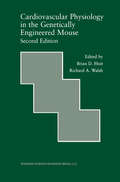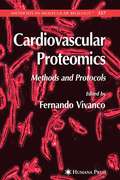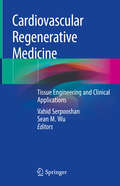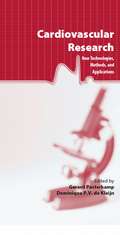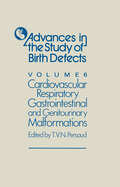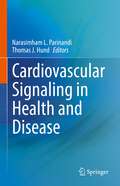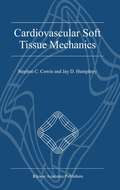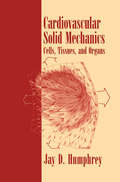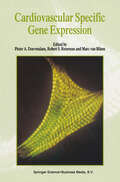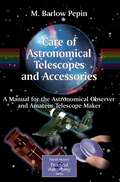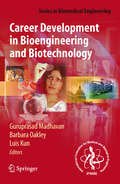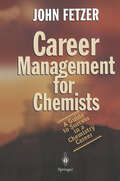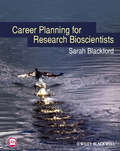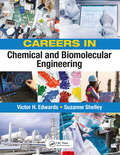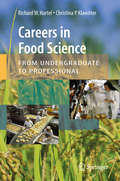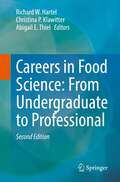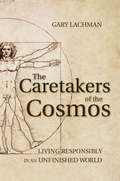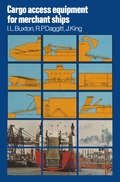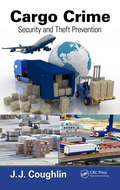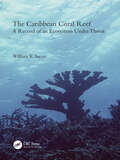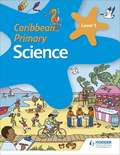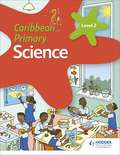- Table View
- List View
Cardiovascular Physiology in the Genetically Engineered Mouse (Developments in Cardiovascular Medicine #238)
by William H. Isbell Helaine SilvermanThe enormous advances in molecular biology and genetics coupled with the progress in instrumentation and surgical techniques have produced a voluminous and often bewildering quantity of data. The need for a second edition of Cardiovascular Physiology in the Genetically Engineered Mouse is underscored not only by these rapid advances, but by the increasing numbers of scientists who have focussed their research on genetically engineered mice. It is the primary objective of this second edition to interpret critically the literature and to provide a framework for the enormous amount of information in this burgeoning field. As in the first edition, the monograph serves as a practical guide for the investigator interested in the functional methods used to characterize the murine cardiovascular phenotype. However, this guidebook is a more comprehensive text than its predecessor; although the major objectives enumerated in the first edition have not substantially changed, they have been refined in keeping with the increased sophistication of the molecular biologist, geneticist, and physiologist in each other's discipline. Each chapter has been expanded and updated, richly enhanced with original tables and figures, and in many cases, extensively rewritten. Eight chapters written by internationally recognized experts have been added; this represents a 43 % increase from the first edition.
Cardiovascular Proteomics: Methods and Protocols (Methods in Molecular Biology #357)
by Fernando VivancoThis cutting-edge book presents protocols and strategies for proteomic evaluation of cardiovascular disease written by pioneering researchers in the field. Topics explored in this comprehensive volume include obtaining specific heart proteins, techniques for identifying risk biomarkers of atherome plaque rupture, analyzing the secretome of explanted endarterectomies cultured in vitro, and phage display techniques for deciphering the molecular diversity of blood vessels.
Cardiovascular Regenerative Medicine: Tissue Engineering and Clinical Applications
by Vahid Serpooshan Sean M. WuThis book is a comprehensive and up-to-date resource on the use of regenerative medicine for the treatment of cardiovascular disease. It provides a much-needed review of the rapid development and evolution of bio-fabrication techniques to engineer cardiovascular tissues as well as their use in clinical settings. The book incorporates recent advances in the biology, biomaterial design, and manufacturing of bioengineered cardiovascular tissue with their clinical applications to bridge the basic sciences to current and future cardiovascular treatment. The book begins with an examination of state-of-the-art cellular, biomaterial, and macromolecular technologies for the repair and regeneration of diseased heart tissue. It discusses advances in nanotechnology and bioengineering of cardiac microtissues using acoustic assembly. Subsequent chapters explore the clinical applications and translational potential of current technologies such as cardiac patch-based treatments, cell-based regenerative therapies, and injectable hydrogels. The book examines how these methodologies are used to treat a variety of cardiovascular diseases including myocardial infarction, congenital heart disease, and ischemic heart injuries. Finally, the volume concludes with a summary of the most prominent challenges and perspectives on the field of cardiovascular tissue engineering and clinical cardiovascular regenerative medicine.Cardiovascular Regenerative Medicine is an essential resource for physicians, residents, fellows, and medical students in cardiology and cardiovascular regeneration as well as clinical and basic researchers in bioengineering, nanomaterial and technology, and cardiovascular biology.
Cardiovascular Research: New Technologies, Methods, and Applications
by Gerard Pasterkamp Dominique De KleijnIn the last decade, technical improvements have changed the inventory of many research laboratories. New techniques and discoveries continuously give rise to observations that result in the de?nition of new research objectives. In the past, - search departments were clearly demarcated. Nowadays, technology that is shared by all lines of research stimulates convergence of research interests. This also - plies to cardiovascular research. Vascular occlusive disease is now core business for researchers employed by cardiology, vascular surgery, vascular medicine, - diology, cell biology, chemistry, physiology, and many other areas. Knowledge on actual research development is shared by researchers with different skills. It is sometimes dif?cult to acquire expertise when a researcher feels his experimental work could be improved by introducing a new research technique. In this book, the investigator will ?nd an overview of recent developments that are relevant for research in general but cardiovascular research in particular. Genomics, p- teomics, microarray, RNAi, stem cells, and progenitor cells are just some phrases that have become increasingly prevalent in literature in the last few years and that are recognized by many, but are fully understood by few. In this book, experts share the most appreciated new developments and techniques in cardiovascular research. We hope that this book will help the reader who is working in the ?eld of cardiovascular research to understand and critically appreciate current research, and that it will help improve the quality of experimental work. Dr G.
Cardiovascular, Respiratory, Gastrointestinal and Genitourinary Malformations (Advances in the Study of Birth Defects #6)
by T. V. N. Persaud M. P. PersaudBirth defects have assumed an importance even greater now than in the past because infant mortality rates attributed to congenital anomalies have declined far less than those for other causes of death, such as infectious and nutritional diseases. As many as 50 % of all pregnancies terminate as miscarriages, and in the majority of cases this is the result of faulty intrauterine development. Major congenital malformations are present in at least 2 % of all liveborn infants, and 22 % of all sti1Ibirths and infant deaths are associated with severe congenital anomalies. Not surprisingly, there has been a great proliferation of research into the problems of developmental abnormalities over the past few decades. This series, Advances in the Study of Birth Defects, was conceived in order to provide a comprehensive focal source of up-to-date information for physi cians concerned with the health of the unborn child and for research workers in the fields of fetal medicine and birth defects. The first four volumes featured recent experimental work on selected areas of high priority and intensive investigation, including mechanisms of teratogenesis, teratological evaluation, molecular and cellular aspects of abnormal development, and neural and behavioural teratology. It seems logical and timely that the clinical aspects should now be presented. Accordingly, leading experts were invited to review a broad range of common problems from the standpoint of embryology, aetiology, clinical manifestations, diagnosis and management. This volume deals with cardiovascular, respiratory, gastrointestinal, and genitourinary malformations.
Cardiovascular Signaling in Health and Disease
by Narasimham L. Parinandi Thomas J. HundThis contributed volume focuses on cardiovascular diseases (CVDs), and explores the ways in which signaling mechanisms at the biochemical, molecular, and cellular levels in the blood vessels (vascular) and heart contribute to the underlying causes of development and progression of the CVDs. This volume covers unique topics such as oxidant signaling in vascular and heart diseases and health, cytoskeletal signaling in vascular health and disease, phospholipase signaling in CVDs, lipid signaling in vascular and myocardial health and diseases, and drug discovery in cellular signaling for cardiovascular diseases.This book assembles the most important discoveries made by leaders on the cellular signaling mechanisms operating behind the development and progression of life-threatening CVDs. It is an extremely useful resource for the investigators in the field of CVDs, and opens the discussion for further discovery of efficient management and effective treatment of the CVDs.
Cardiovascular Soft Tissue Mechanics
by Stephen C. Cowin Jay D. HumphreyThis special volume of the Journal of Elasticity represents the first in a new p- gram dedicated to the occasional publication of collections of invited, reviewed papers of topical interest. The purpose of this program is to spotlight the dev- opments and applications in the mechanics of materials within specific areas that can enhance growth and provide insight for the advancement of the field as well as promote fundamental understanding and basic discovery. Soft Tissue Mechanics is an area of biomechanics that draws heavily upon f- damental ideas and material models from nonlinear elasticity and viscoelasticity. A major goal of this research is to understand those mechanics properties of heart, artery, collagen and skeletal muscle tissue that can be used for the diagnosis of health problems and the improvement of human life. This volume illustrates how experiment, modeling and computation is currently employed in this emerging field. May 2001 ROGER FOSDICK Editor-in-Chief Journal of Elasticity 61: ix–xii, 2000. ix Preface There are two primary areas for the application of elasticity in the biomechanics of tissues: hard tissue mechanics (e.g., bone, teeth, horns, etc.) and soft tissue - chanics (e.g., skin, tendons, arteries, etc.). The distinguishing feature between these tissue types is the amount of physiological “normal” deformation they experience. While “hard” tissues only experience small deformations, soft tissues typically experience large deformations. From a biomechanics viewpoint soft tissues fall within the realm of finite elasticity.
Cardiovascular Solid Mechanics: Cells, Tissues, and Organs
by Jay D. HumphreyThis text presents a general introduction to soft tissue biomechanics. One of its primary goals is to introduce basic analytical, experimental and computational methods. In doing so, it enables readers to gain a relatively complete understanding of the biomechanics of the heart and vasculature.
Cardiovascular Specific Gene Expression (Developments in Cardiovascular Medicine #214)
by Pieter A. Doevendans Robert S. Reneman Marc Van BilsenImproving our insights into the genetic predisposition to cardiovascular disease is one of the most important challenges in our field in the next millennium, not only to unravel the cause of disease but also to improve the selection of patients for particular treatments. Nowadays, for example, subjects with a cholesterol above a particular plasma level are exposed to a cholesterol lowering regime based upon the beneficial outcome of epidemiological studies which include subjects not prone to the disease, despite a plasma cholesterol above the accepted level. Identification of the patients who are genetically predisposed to the consequences of this disorder will reduce the number of subjects unnecessarily treated and, hence, the costs of health care. Because in most cardiovascular diseases the genetic component is a consequence of more than one gene defect, only limited progress has as yet been made in identifying subjects genetically at risk. For example, in hypertension only in less than 10% of the patients the genetic defect has been identified. It has been known for quite some time that in heart and blood vessels fetal genes are as high blood pressure and upregulated or induced when they are exposed to such disorders ischemia. Little is known about the function of these genes in the cardiac and vascular adaptation to these disorders; only guesses can be made.
Care of Astronomical Telescopes and Accessories: A Manual for the Astronomical Observer and Amateur Telescope Maker (The Patrick Moore Practical Astronomy Series)
by M. Barlow PepinCommercially-made astronomical telescopes are better and less expensive than ever before, and their optical and mechanical performance can be superb. When a good-quality telescope fails to perform as well as it might, the reason is quite probably that it needs a little care and attention! Here is a complete guide for anyone who wants to understand more than just the basics of astronomical telescopes and accessories, and how to maintain them in the peak of condition. The latest on safely adjusting, cleaning, and maintaining your equipment is combined with thoroughly updated methods from the old masters. Here, too, are details of choosing new and used optics and accessories, along with enhancements you can make to extend their versatility and useful lifetime. This book is for you. Really. Looking after an astronomical telescope isn’t only for the experts - although there are some things that only an expert should attempt - and every serious amateur astronomer will find invaluable information here, gleaned from Barlow Pepin's many years’ experience working with optical instruments.
Career Development in Bioengineering and Biotechnology (Series in Biomedical Engineering)
by Barbara Oakley Luis Kun Guruprasad MadhavanThis indispensable guide provides a roadmap to the broad and varied career development opportunities in bioengineering, biotechnology, and related fields. Eminent practitioners lay out career paths related to academia, industry, government and regulatory affairs, healthcare, law, marketing, entrepreneurship, and more. Lifetimes of experience and wisdom are shared, including "war stories," strategies for success, and discussions of the authors’ personal views and motivations.
Career Management for Chemists: A Guide to Success in a Chemistry Career
by John FetzerJohn Fetzer’s "Career Management for Chemists" provides ample, common-sense guidance on the key topics such as: Resumés and CVs, Staying Driven & Current, Personal Skills & Traits Networking, Teamwork & Leadership, Speaking & Listening Writing Research Papers, Mentoring, Behavior & Rewards The practical coverage reflects not only his long professional experience but also his insight that, especially in today’s changing workplace, expectations and strategies for career management require constant re-evaluation. Provides real, common-sense, and proven means to enrich and make more rewarding a technical career. Pre-publication comments from colleagues - "Not only the student who is taking his first steps in the scientific world would profit abundantly by mining this book for views and ideas on the different sides of his chosen career. Also the seasoned scientist will be stimulated to scrutinize his own habits and pick up new thoughts, thereby becoming a more skilled instructor of his younger colleagues." J. Andersson, University of Münster, Germany "As one of the international collaborators of Dr. John Fetzer, I want to warmly congratulate him. His efforts nicely summarize very important topics for all who work in scientific activities. But, at the same time, Career Management for Chemists also provides some real insights for many people who are not working in science. This is a nice guidebook on how to enrich our lives and help us to become more successful!! K. Jinno, Toyohashi University of Technology
Career Planning for Research Bioscientists
by Sarah BlackfordCareer Planning for Research Bioscientists is an essential careers guide for bioscience doctoral students and postdoctoral researchers. It contains a wealth of information and resources specifically targeted at research bioscientists, with practical strategies to enhance career success in an increasingly competitive job market. Advice on how to write a winning CV together with examples adapted for different jobs is presented, as well as practical exercises to assist with skills analysis and decision making. Profiles of PhD-qualified bioscienstists in a range of professions including academic research, industry, science communication, management and consultancy provide valuable insights into how others have managed their careers, and tactics such as networking and using social media demonstrate how new opportunities can be discovered. The content of this book is aimed primarily at research bioscientists, however much of the advice and information will be a useful reference for other students and researchers looking for an effective career planning strategy. A companion website with additional resources is available at www.wiley.com/go/blackford/careerplanning and you can visit Sarah Blackford’s blog at www.biosciencecareers.org for more information.
Career Planning for Research Bioscientists
by Sarah BlackfordCareer Planning for Research Bioscientists is an essential careers guide for bioscience doctoral students and postdoctoral researchers. It contains a wealth of information and resources specifically targeted at research bioscientists, with practical strategies to enhance career success in an increasingly competitive job market. Advice on how to write a winning CV together with examples adapted for different jobs is presented, as well as practical exercises to assist with skills analysis and decision making. Profiles of PhD-qualified bioscienstists in a range of professions including academic research, industry, science communication, management and consultancy provide valuable insights into how others have managed their careers, and tactics such as networking and using social media demonstrate how new opportunities can be discovered. The content of this book is aimed primarily at research bioscientists, however much of the advice and information will be a useful reference for other students and researchers looking for an effective career planning strategy. A companion website with additional resources is available at www.wiley.com/go/blackford/careerplanning and you can visit Sarah Blackford’s blog at www.biosciencecareers.org for more information.
Careers in Chemical and Biomolecular Engineering
by Victor Edwards Suzanne ShelleyThe scope of opportunities in chemical and biomolecular engineering has grown tremendously in recent years. Careers in Chemical and Biomolecular Engineering conveys the breadth and depth of today’s chemical and biomolecular engineering practice, and describes the intellectually enriching, socially conscious and financially lucrative opportunities available for such graduates in an ever-widening array of industries and applications. This book aims to help students interested in studying chemical engineering and biomolecular engineering to understand the many potential career pathways that are available in these dynamic fields — and is an indispensable resource for the parents, teachers, advisors and guidance counselors who support them, In addition to 10 chapters that discuss the roles such graduates play in many diverse industries, this book also features 25 Profile articles that share in-depth, first-person insight from industry-leading chemical and biomolecular engineers. These technical professionals discuss their work and educational experiences (in terms of both triumphs and challenges), and share wisdom and recommendations for students pursuing these two dynamic engineering disciplines.
Careers in Chemical and Biomolecular Engineering
by Victor Edwards Suzanne ShelleyThe scope of opportunities in chemical and biomolecular engineering has grown tremendously in recent years. Careers in Chemical and Biomolecular Engineering conveys the breadth and depth of today’s chemical and biomolecular engineering practice, and describes the intellectually enriching, socially conscious and financially lucrative opportunities available for such graduates in an ever-widening array of industries and applications. This book aims to help students interested in studying chemical engineering and biomolecular engineering to understand the many potential career pathways that are available in these dynamic fields — and is an indispensable resource for the parents, teachers, advisors and guidance counselors who support them, In addition to 10 chapters that discuss the roles such graduates play in many diverse industries, this book also features 25 Profile articles that share in-depth, first-person insight from industry-leading chemical and biomolecular engineers. These technical professionals discuss their work and educational experiences (in terms of both triumphs and challenges), and share wisdom and recommendations for students pursuing these two dynamic engineering disciplines.
Careers in Food Science: From Undergraduate To Professional
by Christina P. Klawitter Richard W. HartelCareers in Food Science provides detailed guidelines for students and new employees in the food industry to ensure a successful start to their career. Every step towards a rewarding career in this rapidly evolving industry is covered, from which classes to take in college and which degrees to earn, to internships, and finally how to land, and keep, the first job. This book also provides day-to-day examples of what to expect from the many jobs available to help students decide what to do and where to go. The food industry includes a wide array of fields and careers not only in food production and in academia, but also in government and research institutions. In fact, it is estimated that by 2010 there will be 52,000 annual job openings for college graduates in the Food, Agriculture, and Natural Resources system in the U.S. alone. Written by people who have experience or are currently working in each sector, this book seeks to shed some light on starting, or furthering, a career in this exciting field.
Careers in Food Science: From Undergraduate to Professional
by Richard W. Hartel Christina P. Klawitter Abigail E. ThielCareers in Food Science provides detailed guidelines for students and new employees in the food industry to ensure a successful start to their career. Every step towards a rewarding career in this rapidly evolving industry is covered, from which classes to take in college and which degrees to earn, to internships, and finally how to land, and keep, the first job. This book also provides day-to-day examples of what to expect from the many jobs available to help students decide what to do and where to go. This second edition includes nine new chapters covering research chefs, food systems, social justice, food waste, start-ups, sustainability, and management. Several new authors offer fresh perspectives.
The Caretakers of the Cosmos: Living Responsibly in an Unfinished World
by Gary LachmanDrawing on esoteric, spritual and philosophical thought, this book cononsiders the all-important question -- why are we here? -- and offers a counter-argument to the current nihilsm prevalent in our world.
Cargo Access Equipment for Merchant Ships
by Ian Lyon BuxtonAs President of International MacGregor I am deeply indebted to the authors of this excellent book for the very considerable amount of work and scholarship it contains. It is the first authoritative work on cargo access equipment to be pubbshed and I am sure that it will be greatly welcomed by the Marine Industries. You will see from the authors' preface that the book was commissioned by the Henri Kummerman Foundation which was established in 1976 to assist and promote internationally research and development in the field of marine transportation and cargo handling. The Foundation has already made a number of grants to universities and to students but this book is its first major contribution to the furthering of education in the Marine Industries. For me, it is a rewarding fruition of a long involvement in maritime affairs. However, much requires to be done in the future and the Foundation can only succeed if it is encouraged and assisted by people who are forward thinking. I should be pleased therefore to hear from any readers of this book if they feel that they can help or be helped within the aims and objectives of the Foundation. 28 Chemin du Pommier, HENRI KUMMERMAN 1218 Geneva, Switzerland.
Cargo Crime: Security and Theft Prevention
by John J. CoughlinCargo crime including theft, fraud, and the passage of contraband through commercial shipping lanes poses an enormous threat to security and the economy. By understanding the current methods and operations of those who attack the supply chain, industry professionals can design effective security plans and law enforcement can properly investigate th
The Caribbean Coral Reef: A Record of an Ecosystem Under Threat
by William K. SaccoThis book is a visual tour of Caribbean coral reefs between 1968 and 1978. They are the world’s second largest coral reef community and the most threatened. The Caribbean Coral Reef: A Record of an Ecosystem Under Threat offers a priceless historical record made by a photographer who set out to document the major reef species when those reefs were at their prime. Today, coral reefs are under threat as never before and, sadly, most of what is shown in the book's photographs is now gone forever. It is only by comparing the images in this book with what we see now that we are able to fully recognize what we have lost. With its stunning photography and precise, accurate scientific information, this book offers students of coral reefs a wealth of information about this rich, fragile ecosystem. It is also written accessibly for non-academic visitors to the Caribbean reef or anyone interested in the earth’s creatures. Many of the invertebrates will be unfamiliar to most people, and the author reveals fascinating insights into these otherworldly creatures and their lifestyles. Enjoy this field guide to the reefs that were, and savor the beauty of this vanishing environment and its organisms.
The Caribbean Coral Reef: A Record of an Ecosystem Under Threat
by William K. SaccoThis book is a visual tour of Caribbean coral reefs between 1968 and 1978. They are the world’s second largest coral reef community and the most threatened. The Caribbean Coral Reef: A Record of an Ecosystem Under Threat offers a priceless historical record made by a photographer who set out to document the major reef species when those reefs were at their prime. Today, coral reefs are under threat as never before and, sadly, most of what is shown in the book's photographs is now gone forever. It is only by comparing the images in this book with what we see now that we are able to fully recognize what we have lost. With its stunning photography and precise, accurate scientific information, this book offers students of coral reefs a wealth of information about this rich, fragile ecosystem. It is also written accessibly for non-academic visitors to the Caribbean reef or anyone interested in the earth’s creatures. Many of the invertebrates will be unfamiliar to most people, and the author reveals fascinating insights into these otherworldly creatures and their lifestyles. Enjoy this field guide to the reefs that were, and savor the beauty of this vanishing environment and its organisms.
Caribbean Primary Science Book 1 (Caribbean Primary Science)
by Karen Morrison Milly Fullick Lisa GreensteinOpen up the world of science to your students, enthusing and encouraging them to become focused, questioning and successful scientists, thinkers and problem-solvers. Science and technology encompass some of the most important skills children need to master in the modern world. This series introduces and develops the building blocks of science study, ensuring student interest and academic progression continue hand-in-hand throughout the primary school and on into secondary education.- new, appealing resource planned and designed to make each student feel and work like a scientist- language controlled with vocabulary support for students, plus full support for non-specialist teachers- features special projects and research projects to build skills towards the end of primary examinations- focus on practical work, green technologies, environmental issues and science in daily life.
Caribbean Primary Science Book 2 (Caribbean Primary Science)
by Karen Morrison Milly Fullick Lisa GreensteinOpen up the world of science to your students, enthusing and encouraging them to become focused, questioning and successful scientists, thinkers and problem-solvers. Science and technology encompass some of the most important skills children need to master in the modern world. This series introduces and develops the building blocks of science study, ensuring student interest and academic progression continue hand-in-hand throughout the primary school and on into secondary education.- new, appealing resource planned and designed to make each student feel and work like a scientist- language controlled with vocabulary support for students, plus full support for non-specialist teachers- features special projects and research projects to build skills towards the end of primary examinations- focus on practical work, green technologies, environmental issues and science in daily life.
